Embark on a mesmerizing journey to witness one of nature’s most spectacular displays right in the heart of Ontario. The Northern Lights, or Aurora Borealis, transform the night sky into a canvas of vibrant colors, offering a breathtaking spectacle unlike any other. Ontario, with its vast wilderness and minimal light pollution, hosts some of the best places to see Northern Lights. From the secluded shores of Lake Superior to the dark skies of Torrance Barrens, this guide will unveil top places to see Northern Lights in Ontario, ensuring you know exactly where and when to capture this celestial dance. Whether you’re a seasoned aurora hunter or a first-time viewer, get ready to explore Ontario’s best places to see Northern Lights, where nature’s magic lights up the dark skies.
15 Best Places to See Northern Lights in Ontario
- Torrance Barrens Dark-Sky Preserve
- Gordon’s Park, Manitoulin Island
- Lake Superior Provincial Park
- Pukaskwa National Park
- Fort Albany
- Moosonee
- Bruce Peninsula National Park
- Algonquin Provincial Park
- Sioux Lookout
- Killarney Provincial Park
- Fushimi Lake Provincial Park
- Quetico Provincial Park
- Polar Bear Provincial Park
- Kakabeka Falls Provincial Park
- Eagle Lake, near Dryden
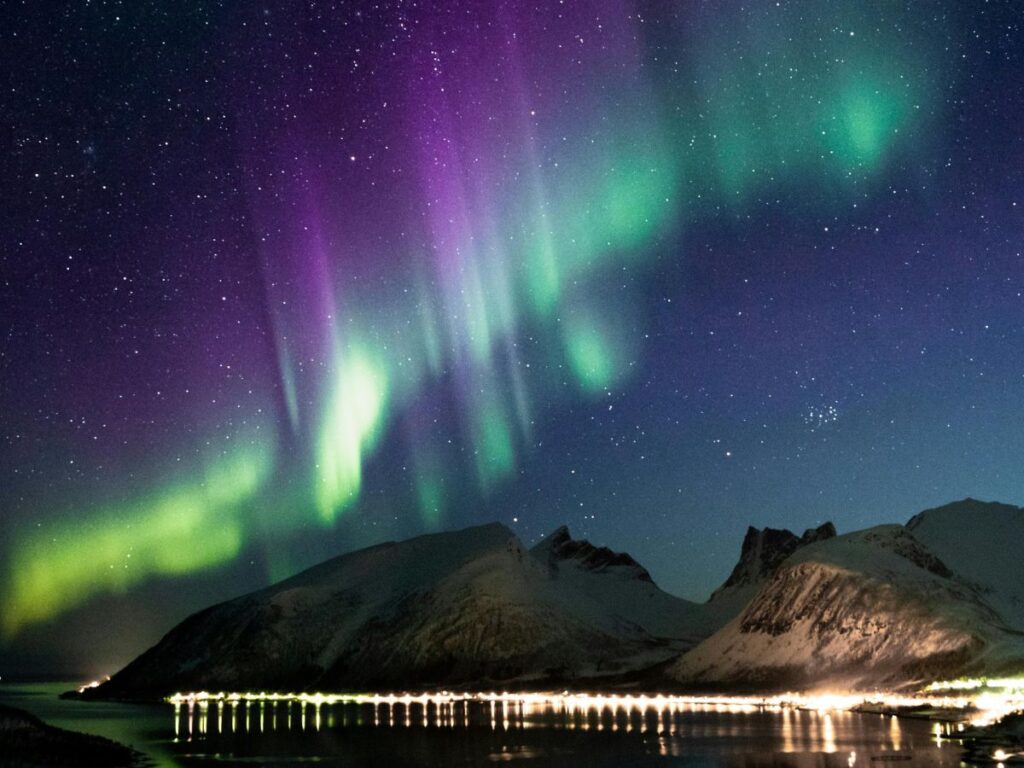
Torrance Barrens Dark-Sky Preserve
Situated in the heart of Muskoka, Torrance Barrens Dark-Sky Preserve is one of the top places to see Northern Lights in Ontario. This area is internationally recognized for its exceptionally dark skies, free from urban light pollution, making it an ideal spot for viewing the Aurora Borealis. The preserve offers a rugged landscape with rock barrens, wetlands, and forested areas, providing a stunning natural backdrop for night sky observation. Amenities such as designated viewing platforms and marked trails enhance the experience. Visitors are advised to check for any permits required for overnight stays, although the preserve is accessible year-round. The best times to witness the Northern Lights here are from late fall to early spring, when the nights are longest and the skies are clearest. The Torrance Barrens not only offers a unique opportunity to see this natural phenomenon but also serves as a perfect spot for stargazing and connecting with nature.
Address: Southwood Rd, Gravenhurst, ON P0C 1M0, Canada
Gordon’s Park, Manitoulin Island
Gordon’s Park on Manitoulin Island is celebrated as one of Ontario’s best places to see Northern Lights due to its minimal light pollution and panoramic views. This eco-park provides an exceptional dark sky experience, making it a haven for astronomers and nature enthusiasts alike. The park is equipped with a range of amenities, including camping sites, a heated pool, and educational programs about the night sky. Special permits are not typically required for entry, but reservations for camping or special events are recommended. Combine your Northern Lights viewing with a unique retreat by exploring the best glamping spots in Ontario for an unforgettable experience. The park’s unique position on Manitoulin Island, surrounded by the waters of Lake Huron, creates ideal conditions for viewing the Northern Lights, especially during the peak months of September and March. In addition to aurora viewing, the park offers a range of outdoor activities like hiking and bird watching, making it a versatile destination for both day and night explorations.
Address: Tehkummah on Manitoulin Island
Lake Superior Provincial Park
Lake Superior Provincial Park is renowned for its dramatic landscapes and as one of the best places to see Northern Lights in Ontario. Covering a vast area along the shores of Lake Superior, the park features rugged cliffs, ancient forests, and a diverse range of wildlife, creating a spectacular setting for nature lovers. The park’s northern latitude and dark sky make it a prime location for observing the Aurora Borealis. Visitors can enjoy a variety of amenities, including campgrounds and backcountry camping, with appropriate permits required for overnight stays. The best viewing times are from late autumn to early spring, when the skies are the darkest. What makes Lake Superior Provincial Park particularly special is not just its aurora potential but also its rich cultural heritage, showcased through numerous pictographs on cliff faces by the Ojibwe people centuries ago, adding a layer of historical intrigue to the aurora viewing experience.
Address: Algoma, Unorganized, North Part, ON, Canada
Contact: +1 705-856-2284
Pukaskwa National Park
Pukaskwa National Park is one of the premier parks to see Northern Lights in Ontario, offering pristine wilderness and spectacular coastlines along Lake Superior. Known for its remote and rugged beauty, the park features dense forests, dramatic rocky shores, and traditional Anishinaabe cultural experiences. This national park provides excellent dark-sky conditions, making it a prime spot for viewing the Aurora Borealis, especially during the peak seasons in late autumn and early spring. The park offers a range of amenities, including campgrounds and backcountry sites, with permits required for overnight stays to ensure the preservation of its natural environment. The isolation of Pukaskwa National Park not only enhances the Northern Lights viewing experience but also offers visitors a chance to disconnect and immerse themselves in nature’s untouched beauty. Hiking trails and canoe routes add to the outdoor activities that make a visit here uniquely rewarding. Enhance your Northern Lights trip with a visit to some of the top hiking trails in and around Toronto to enjoy nature’s beauty all year round.
Address: ON-627, Heron Bay, ON P0T 1R0, Canada
Contact: +1 807-229-0801
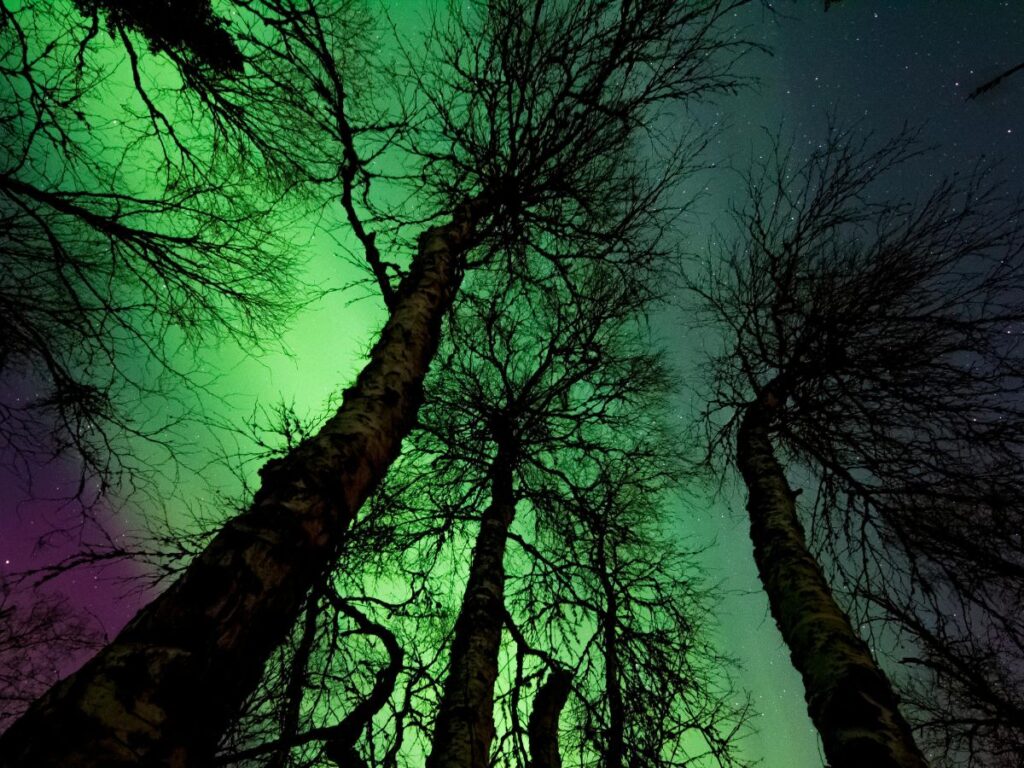
Fort Albany
Fort Albany, located near James Bay, is a small, remote Cree community that stands out as one of the best places to see Northern Lights in Ontario due to its northern position and minimal light pollution. The community itself is steeped in rich history and culture, offering visitors a unique perspective on the Northern Lights experience intertwined with Indigenous heritage. The viewing conditions here are optimal, particularly during the colder months when the skies are clearest and the nights are longest. While amenities in Fort Albany are more basic compared to larger parks, the authenticity and cultural enrichment add significant value to the aurora viewing experience. Visitors should be prepared for the remoteness of the location, bringing necessary supplies and arranging accommodations in advance, as the community is accessible mainly by air or seasonal roads.
Moosonee
Moosonee, often referred to as “The Gateway to the Arctic,” provides a unique backdrop for observing the Northern Lights, one of the top places to see Northern Lights in Ontario. Located on the Moose River, approximately 19 kilometers south of James Bay, Moosonee offers a combination of tundra-like landscapes and boreal forests, creating stunning vistas for night sky watchers. The town is accessible only by train or air, which helps maintain its dark skies, ideal for aurora viewing. While the amenities are not as extensive as in more developed tourist areas, the local lodges and guest houses provide comfortable accommodations. The best times to visit Moosonee for Northern Lights are during the late winter and early spring months, when the nights are longest. Additionally, the town’s unique position provides not just a haven for photographers and nature enthusiasts but also an opportunity to learn about the local Cree culture, enhancing the visitor experience with cultural depth.
Bruce Peninsula National Park
Bruce Peninsula National Park, located between Georgian Bay and the main basin of Lake Huron, is renowned for its rugged limestone cliffs and crystal-clear waterways, making it a picturesque setting for viewing the Northern Lights. This park is one of the top places to see Northern Lights in Ontario due to its dark skies, which are preserved by its status as part of the Niagara Escarpment World Biosphere Reserve. The park offers a variety of amenities including campsites, yurts, and hiking trails, with permits required for camping to protect its natural environment. The best times to catch the Aurora Borealis here are during the fall and winter months when the nights are longer and clearer. Bruce Peninsula’s unique geographic features, like the Grotto and Fathom Five National Marine Park, provide spectacular night-time viewing points that are as stunning by night as they are by day.
Address: Tobermory, ON N0H 2R0, Canada
Contact: +1 519-596-2233
Algonquin Provincial Park
Algonquin Provincial Park is one of Ontario’s most popular and expansive wilderness parks, known for its vast boreal forests and network of lakes. This park is a favored destination not only for its beauty and wildlife but also as one of the best places to see Northern Lights in Ontario. The park’s size and remote location allow for excellent dark-sky conditions, ideal for Aurora Borealis sightings. Facilities include several campgrounds and rustic cabins, with appropriate permits required for access and overnight stays. Algonquin is best visited for Northern Lights during the late autumn to early spring, when the reduced humidity and longer nights provide optimal viewing conditions. The park also offers educational programs about the night sky, adding a learning dimension to the aurora viewing experience, making it particularly special as the best place to see Northern Lights in Ontario for families and educational groups.
Address: Ontario 60, Ontario K0J 2M0, Canada
Contact: +1 705-633-5572
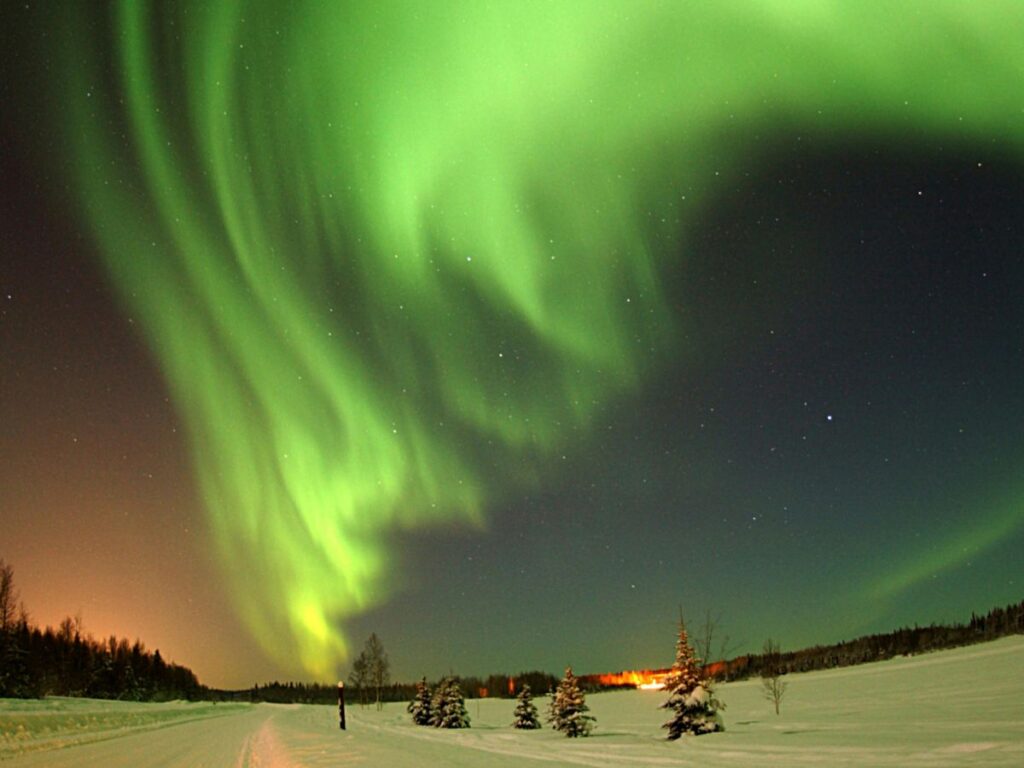
Sioux Lookout
Sioux Lookout, known as the “Hub of the North,” is strategically positioned in Northwestern Ontario, providing some of the best viewing conditions for the Northern Lights due to its northern latitude and low light pollution. This small town is surrounded by hundreds of lakes and dense boreal forests, creating a stunning natural environment for night sky viewing. The amenities in Sioux Lookout cater well to tourists, including hotels, guest houses, and wilderness lodges, making it accessible for those seeking both comfort and adventure. The best time to visit Sioux Lookout for Northern Lights is during the winter months when the skies are at their clearest. The town’s annual Blueberry Festival and other cultural events offer additional attractions for visitors, making it a unique blend of natural beauty and community spirit, ideal for those looking to enhance their Northern Lights adventure with local flavors and activities.
Killarney Provincial Park
Killarney Provincial Park, nestled along the Georgian Bay coast, is famous among the best spots to see Northern Lights in Ontario for its white quartzite cliffs and sapphire blue lakes, providing a dramatic backdrop for viewing the Northern Lights. As one of the top places to see Northern Lights in Ontario, the park boasts exceptional dark-sky quality, thanks to its location away from major urban centers. The park offers a variety of accommodations, including campgrounds and backcountry campsites, with necessary permits required for overnight stays. The best viewing times are during the colder months, from late autumn to early spring, when nights are longer and skies clearer. Killarney is not just a haven for aurora watchers but also attracts kayakers, hikers, and winter sports enthusiasts, making it a year-round destination for outdoor lovers. The park’s natural beauty is complemented by its commitment to preserving the wilderness, offering a pristine environment for both ecological study and recreational activities.
Address: 960 ON-637, Killarney, ON P0M 2A0, Canada
Contact: +1 705-287-2900
Fushimi Lake Provincial Park
Located near Hearst in northern Ontario, Fushimi Lake Provincial Park is a hidden gem for aurora enthusiasts and one of the best places to see Northern Lights in Ontario. This park features a large, scenic lake surrounded by mixed forests, providing tranquil and dark conditions ideal for night sky observations. The park has well-maintained amenities including a campground with sites available for both tents and RVs, boat launches, and picnic areas. Permits are required for camping and can be obtained from the park office. Fushimi Lake is particularly noted for its excellent fishing opportunities, adding another layer of attraction for visitors. The best times for Northern Lights viewing are from September to April, when the skies are darkest. The remote location and serene setting make Fushimi Lake a perfect spot for those looking to escape the hustle and bustle and enjoy nature’s nighttime display.
Address: Neely Rd, Hearst, ON P0L 1N0, Canada
Contact: +1 705-372-5909
Quetico Provincial Park
Quetico Provincial Park, bordering Minnesota’s Boundary Waters Canoe Area Wilderness, is renowned for its rugged beauty and pristine landscapes, making it an ideal spot for viewing the Northern Lights. This park is one of Ontario’s largest, offering over 460,000 hectares of unspoiled wilderness filled with dense forests, crystal-clear lakes, and rocky ridges. The park’s remote location ensures minimal light pollution, providing optimal conditions for observing the Aurora Borealis. Visitors can access the park by canoe or on foot, with a variety of backcountry campsites available, requiring permits that can be reserved in advance. The best viewing months are from late fall to spring. Quetico’s unique aspect is its deep connection to Indigenous heritage and the extensive opportunities it offers for wilderness adventures, from paddling extensive water routes to exploring well-preserved portage trails and historic sites, enhancing the aurora viewing experience with a touch of adventure and history.
Address: ON-11, Atikokan, ON P0T 1C0, Canada
Contact: +1 807-597-2735
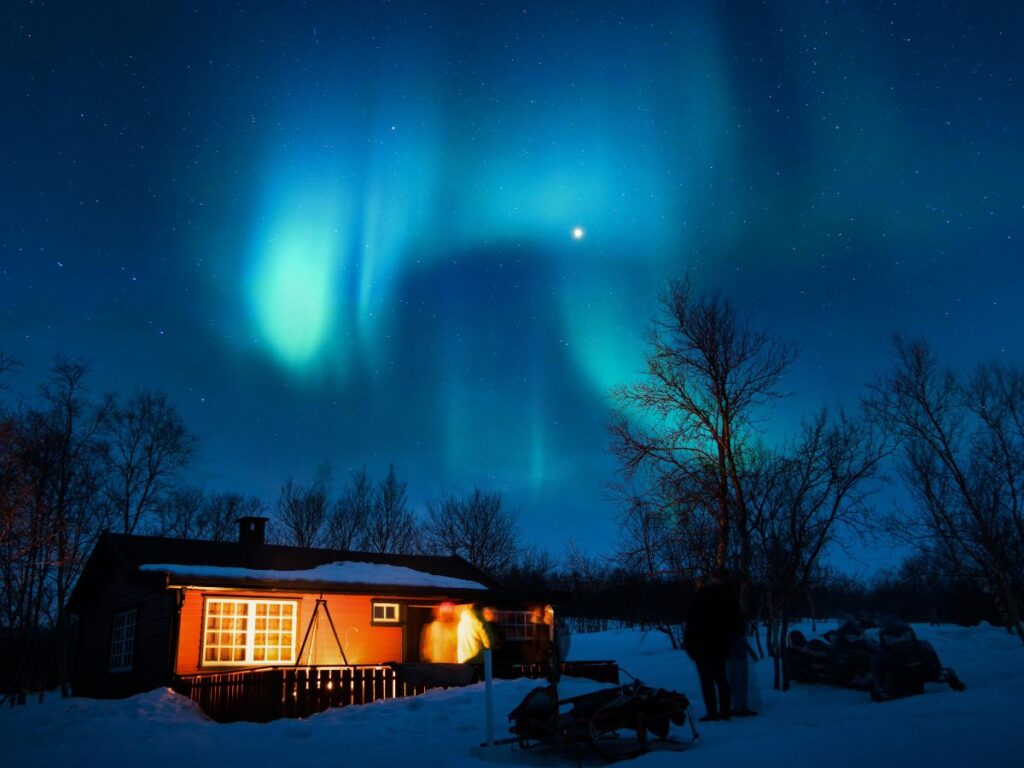
Polar Bear Provincial Park
Polar Bear Provincial Park, situated on the shores of Hudson Bay in northern Ontario, is one of the largest provincial parks and a remote sanctuary ideal for viewing the Northern Lights. Known for its vast subarctic landscapes, the park features tundra, coastal marshes, and rivers, offering a unique and starkly beautiful backdrop for the Aurora Borealis. As there are no roadways leading into the park, access is typically by air, adding to the untouched and pristine nature of this location. The park is a wildlife haven, particularly noted for the polar bears that roam its expanse, which can add an element of adventure to the Northern Lights experience. Viewing conditions are optimal during the colder months when the skies are clear and dark. There are no formal amenities or accommodations within the park, so visitors must be well-prepared for a rugged and self-sufficient trip. Permits are required for entry, and visitors must adhere to strict guidelines to protect both the environment and the wildlife.
Address: 730 2 Third Ave, ON P0L 1C0, Canada
Contact: +1 705-235-1384
Kakabeka Falls Provincial Park
Kakabeka Falls Provincial Park, located just west of Thunder Bay, is famed for its majestic waterfalls, which are among the highest in Ontario, earning it the nickname “the Niagara of the North.” This park provides a picturesque setting for Northern Lights viewing, with the falls creating a dramatic foreground for night-time photography. The park has excellent amenities, including campgrounds, walking trails, and viewing platforms, making it accessible and family-friendly. The park is open year-round, with the best times to view the Northern Lights being during the autumn and winter months when the nights are longest. Kakabeka Falls is not only a top place to see Northern Lights in Ontario but also offers educational programs about the local geology and history, enhancing visitors’ overall experience with informative and engaging activities.
Address: Kakabeka Falls, ON P0T 1W0, Canada
Contact: +1 807-473-9231
Eagle Lake, near Dryden
Eagle Lake, located near Dryden in northwestern Ontario, offers a tranquil and scenic setting ideal for viewing the Northern Lights among the top spots to see Northern Lights in Ontario. This large, clear lake is surrounded by dense forests, providing seclusion and a dark sky environment that is perfect for night sky observations. The area is known for its excellent fishing and outdoor recreational opportunities, including boating and hiking, making it a great destination for nature lovers. The lake has several resorts and lodges, which provide comfortable accommodations and may offer guided tours for aurora viewing. The best time to visit Eagle Lake for Northern Lights is during the winter months when the skies are at their darkest. The community around Eagle Lake is welcoming and provides additional amenities such as equipment rentals and winter sports facilities, ensuring that visitors have a memorable and comfortable stay while chasing the celestial spectacle of the Aurora Borealis.
Address: Kenora District, Ontario, Canada
How to Plan Your Visit
Planning a trip to witness the Northern Lights in Ontario requires careful preparation to enhance your experience and ensure safety. Here are essential tips and recommendations for organizing your visit to the best places to see Northern Lights in Ontario.
What to Bring and Clothing
- Layered Clothing: The best viewing times are during colder months, so dress in warm, insulated layers. Include thermal underwear, a fleece jacket, a windproof and waterproof outer layer, and insulated boots.
- Accessories: Don’t forget warm gloves, a hat, and a scarf. Hand warmers can also provide extra comfort during long nights outdoors.
- Flashlight: A headlamp with a red light option is ideal as it will preserve your night vision while helping you navigate in the dark.
Safety Tips While Exploring Remote Areas at Night
- Always be aware of your surroundings, especially in wildlife-rich areas. Carry a whistle and bear spray where appropriate.
- Always let someone know your plans and expected return time. This is crucial if you are heading into extremely remote areas.
- Carry a GPS device or a map and compass. Make sure you know how to use them before your trip.
Recommended Photographic Equipment for Capturing the Aurora
Camera: A DSLR or mirrorless camera with manual mode capability is essential for capturing the Northern Lights.
Wide-Angle Lens: A wide-angle lens (24mm or wider) with a fast aperture (f/2.8 or faster) will allow you to capture more of the sky and let in enough light for a good exposure.
Tripod: A sturdy tripod is crucial to stabilize your camera for long exposures, which are necessary under low-light conditions.
Extra Batteries: Cold weather can drain camera batteries quickly, so bring extras and keep them warm by storing them close to your body. After witnessing the breathtaking Northern Lights, ensure your photos are printed with the finest quality by checking out our guide to the best photo printing options in Toronto.
By preparing adequately with the right gear, knowledge, and safety precautions, you’ll be set to enjoy the mesmerizing beauty of the Northern Lights across Ontario’s dark skies. Whether you choose a well-equipped park or a remote wilderness area, these tips will help ensure that your Northern Lights adventure is as magical and safe as possible.
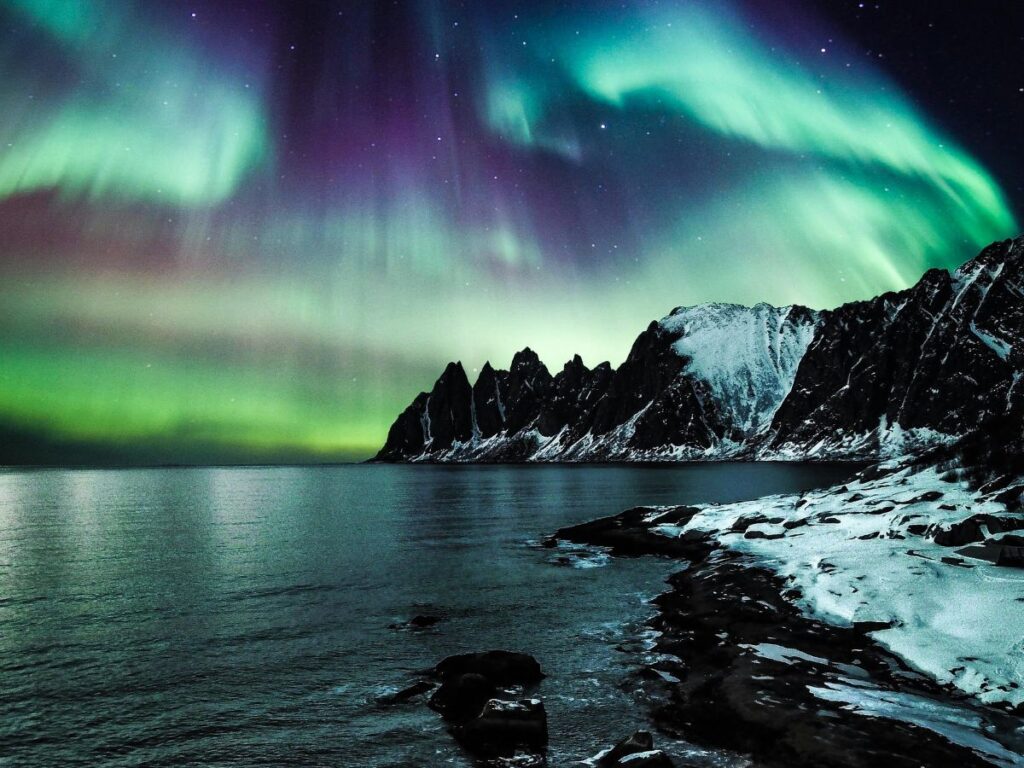
Key Takeaways
- Ontario offers a wide range of locations for viewing the Northern Lights, from remote wilderness parks like Polar Bear Provincial Park to accessible sites like Torrance Barrens Dark-Sky Preserve.
- The best times for observing the Northern Lights in Ontario are during the late autumn to early spring months when nights are longest and skies are darkest.
- Dressing in warm, layered clothing and carrying essential gear such as a red-light headlamp and GPS are crucial for a comfortable and safe viewing experience.
- To capture the aurora effectively, use a DSLR or mirrorless camera with a wide-angle lens and a sturdy tripod, and remember to bring extra batteries to cope with the cold.
- Always inform someone of your travel plans, especially when visiting remote areas, and be prepared with navigation tools and bear spray if necessary.
- Many of these locations not only offer spectacular views of the Northern Lights but also provide opportunities to enjoy unique natural landscapes and learn about local Indigenous cultures.
FAQs
- What are the best months to see the Northern Lights in Ontario?
The best months are from late autumn to early spring when the nights are longest and darkest. - Do I need a permit to visit parks for Northern Lights viewing in Ontario?
Yes, many parks require permits for overnight stays and sometimes even for day visits, so check the specific park’s regulations. - Can the Northern Lights be seen anywhere in Ontario?
While the Northern Lights can potentially be seen across Ontario, locations with dark skies away from city lights offer the best viewing conditions. - Are there guided tours for Northern Lights in Ontario?
Yes, several parks and local tour operators offer guided experiences for Northern Lights viewing. - How long do Northern Lights displays usually last
Displays can last from a few minutes to several hours, depending on solar activity. - Can I see the Northern Lights from Toronto?
It’s possible during strong solar activity, but light pollution significantly reduces visibility. After experiencing the Northern Lights, make the most of your visit by discovering unique activities and hidden gems in Toronto. - Are there any apps or tools to predict when the Northern Lights will be visible?
Yes, there are several apps and websites that provide aurora forecasts and solar activity updates. - What are the best parks in Ontario for Northern Lights photography?
Torrance Barrens Dark-Sky Preserve and Lake Superior Provincial Park are highly recommended for their dark skies.